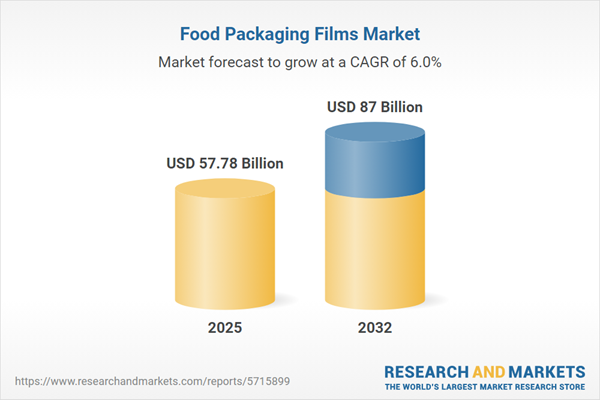Speak directly to the analyst to clarify any post sales queries you may have.
The food packaging films market is evolving rapidly, shaped by rising sustainability standards, technological advancements, and a complex global regulatory environment. Senior decision-makers face shifting demands as packaging formats and supply chain structures continue to transform.
Market Snapshot: Food Packaging Films Market Size and Growth
The food packaging films market grew from USD 54.56 billion in 2024 to USD 57.78 billion in 2025. It is projected to reach USD 87.00 billion by 2032, with an expected CAGR of 6.00%. This robust growth signals a resilient market, supported by regulatory pressures, evolving end-use applications, and continuous innovation in film design and composition.
Scope & Segmentation of the Food Packaging Films Market
This report delivers an in-depth analysis of the food packaging films market, breaking down critical factors related to materials, applications, and regional performance. The study provides strategic insight into the following areas:
- Raw Material: Polyethylene (high density, linear low density, low density), Polyethylene Terephthalate, Polypropylene (copolymer, homopolymer), Polystyrene, and Polyvinyl Chloride.
- End Use Industry: Bakery & Confectionery, Beverages, Convenience & Frozen Food, Dairy, Fruits & Vegetables, Meat & Poultry.
- Packaging Type: Bags, Flexible Pouches, Shrink Films, Stretch Films, Wraps.
- Application: Barrier, Decorative, Labeling, Protective, Sealing.
- Thickness: Heavy, Micro, Standard.
- Orientation: Biaxial, Monoaxial.
- Print Method: Digital, Flexography, Gravure, Lithography.
- Region: Americas (North and Latin America), Europe, Middle East & Africa, Asia-Pacific.
- Companies: Amcor plc, Berry Global Inc., Sealed Air Corporation, Mondi plc, Huhtamäki Oyj, Constantia Flexibles Group GmbH, Uflex Limited, Klöckner Pentaplast Group, Winpak Ltd., Sonoco Products Company.
Key Takeaways for Senior Decision-Makers
- The food packaging films market is responding strongly to sustainability and regulatory trends, with increasing use of mono-material and bio-based solutions.
- Innovations in digital printing and barrier coatings drive brand differentiation and enable shorter, more flexible production runs for diverse applications.
- Supply chain resilience has moved to the forefront, encouraging closer partnerships between resin producers, converters, and brand owners to ensure operational continuity.
- Technical developments in film orientation and thickness profiles allow tailored solutions to meet varying shelf-life and protection needs across end use segments.
- Competitive strategies now center on investment in R&D, digital capabilities, and sustainability initiatives, supported by strategic acquisitions and local market expertise.
Impact of U.S. Tariff Revisions on Supply Chains
The revised U.S. tariff schedules introduced in 2025 have increased material import costs for many converters, prompting companies to explore domestic resin alternatives and recalibrate procurement strategies. Brand owners in the dairy, bakery, and meat sectors are facing divergent impacts, with some able to protect margins through strategic contracts while others experience renewed pricing pressures. Delays in packaging innovation cycles and a renewed focus on adaptive sourcing underline the importance of agile supply chain management in this policy-driven context.
Research Methodology & Data Sources
This report leverages primary interviews with senior executives in resin production, film conversion, and branded manufacturing, supplemented by secondary analysis of industry publications and databases. Quantitative insights are reinforced by segmentation and scenario analysis, with insights validated through expert workshops.
Why This Report Matters for Decision-Makers
- Equips executives with a holistic view of evolving materials and technology adoption to inform both near-term and long-term strategies.
- Enables identification of regional performance drivers and partnership opportunities critical to growth amid regulatory and supply chain disruption.
- Offers actionable recommendations grounded in current trends and validated by industry practitioners.
Conclusion
The food packaging films market is on a trajectory of transformation, driven by sustainability mandates, digital innovation, and shifting competitive priorities. Strategic adaptability and targeted partnerships will be key for organizations navigating future developments in this sector.
Additional Product Information:
- Purchase of this report includes 1 year online access with quarterly updates.
- This report can be updated on request. Please contact our Customer Experience team using the Ask a Question widget on our website.
Table of Contents
3. Executive Summary
4. Market Overview
7. Cumulative Impact of Artificial Intelligence 2025
Companies Mentioned
The companies profiled in this Food Packaging Films market report include:- Amcor plc
- Berry Global Inc.
- Sealed Air Corporation
- Mondi plc
- Huhtamäki Oyj
- Constantia Flexibles Group GmbH
- Uflex Limited
- Klöckner Pentaplast Group
- Winpak Ltd.
- Sonoco Products Company
Table Information
| Report Attribute | Details |
|---|---|
| No. of Pages | 198 |
| Published | November 2025 |
| Forecast Period | 2025 - 2032 |
| Estimated Market Value ( USD | $ 57.78 Billion |
| Forecasted Market Value ( USD | $ 87 Billion |
| Compound Annual Growth Rate | 6.0% |
| Regions Covered | Global |
| No. of Companies Mentioned | 11 |









